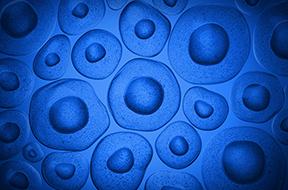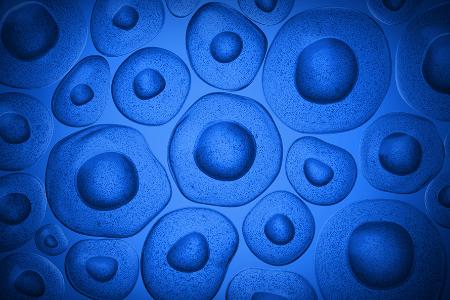Research staff from the IRB Barcelona Cellular Plasticity and Disease laboratory, led by ICREA Researcher Manuel Serrano, proposes a more effective way to limit cell plasticity without damaging them. The Cancer Epigenetics and Nanomedicine Laboratory of the Centre for Research in Nanomaterials and Nanotechnology (CINN-CSIC), led by Mario Fernández Fraga and which also belongs to the Institute of Oncology of the Asturias Principality (IUOPA), the Institute of Health Research of the Asturias Principality (ISPA) and the Network Research Centre for Rare Diseases (CIBERER). From the Oviedo Laboratory, CSIC scientist Agustín Fernández and Marta Sierra also participated in the study. The new mechanism sheds light on processes in which cell plasticity is important, such as cancer and immunology. The work has been published in the journal Nature Cell Biology
A new method discovered to regulate cell plasticity
Cell plasticity is a property by which a cell can acquire several different and reversible identities. Cell plasticity is essential in embryonic development and for the correct functioning of the immune system. This process is also crucial in cancer, since many cancer cells take advantage of this property to resist chemotherapy and invade and colonise different parts of the body.
The study published today in the journal Nature Cell Biology describes a way to regulate cell plasticity by "blocking" cells in one of their possible states. "Many cells, in addition to the activity of the genes that define their identity, have spurious gene expression, a kind of 'background noise'. This is what enables them at any given moment to change their identity and for what was previously 'background noise' to become the dominant genetic programme," explains Serrano.
Regulate gene expression to modulate plasticity
Until now, the method used to block cell plasticity was based on inhibiting the external stimuli that cells receive and thus reducing this gene expression 'background noise'. However, these methods are often incompatible with cell multiplication and some ended up being harmful to the cells themselves.
The new method developed in this study, which is promoted by the 'la Caixa' Foundation, affects the deep mechanism that regulates gene expression, without affecting their viability and being completely reversible. The key to this new pathway lies in the inhibition of the CDK8 protein. "The Cancer Epigenetics and Nanomedicine Laboratory shows that this method does not involve substantial alterations in genomic DNA methylation, which is essential to prevent adverse side effects such as increased chromosomal instability," Mario Fernández Fraga and Agustín Fernández explain from the Laboratory in Oviedo/Uviéu.
"We have seen that inhibiting CDK8 enhances the expression of the genes that determine cell identity, and that this has the secondary effect of turning off the 'background noise'. The cells are therefore fixed in a specific identity and lose their plasticity," said Cian J Lynch, lead author of the study and postdoctoral researcher from the same laboratory.
Important implications in biomedicine
Being able to regulate cell plasticity can have many advantages in biomedical research, since it facilitates the study in the laboratory of all the processes in which plasticity is a key element, such as cancer and embryonic development. The focus of this work was on embryonic stem cells. The great plasticity of these cells makes them very attractive for applications based on cell therapies. However, the high plasticity of these cells poses a challenge when cultivating them in the laboratory.
"Due to the intrinsic plasticity of embryonic stem cells, laboratory cultures are very heterogeneous and the methods that were available to decrease their plasticity were harmful to the cells. It was an unsolved practical problem," explains Raquel Bernad, co-author of the work who has just finished her doctorate. Researchers have shown that it is possible to grow human embryonic stem cells in the presence of a CDK8 inhibitor, making the cultures more homogeneous and without damaging the cells. Something that until now had not been achieved.
Also, research personnel from other laboratories have already observed that this new method may have implications in autoimmune diseases in which the plasticity of T lymphocytes causes them to be present in an excessively active form, causing an exaggerated immune response.
Regarding the implications in oncology, "it is known that a significant cause of resistance to chemotherapy is cell plasticity. By blocking cell plasticity, it is hoped to improve the response to chemotherapy with more homogeneous and lasting responses," adds Serrano.
This work has been possible thanks to the collaboration of Spanish and international institutions such as the National Centre for Oncological Research (CNIO) in Madrid, the University of Cambridge in the UK, the University of Aveiro in Portugal, the Institute of Bioengineering of Catalonia (IBEC) in Barcelona, the Curie Institute, the University of Lyon and the Montpelier Institute of Molecular Genetics in France, the Centre for Research in Nanomaterials and Nanotechnology (CINN-CSIC), the University of Oviedo, the Institute of Oncology of the Asturias Principality (IUOPA), the Asturias Principality Health Research Institute (ISPA), CIBERER and CIBER-BBN.
The work was partially funded by the 'la Caixa' Foundation, the European Research Council (ERC) and the National Plan of the Spanish Ministry for Science and Innovation.
Images gallery




